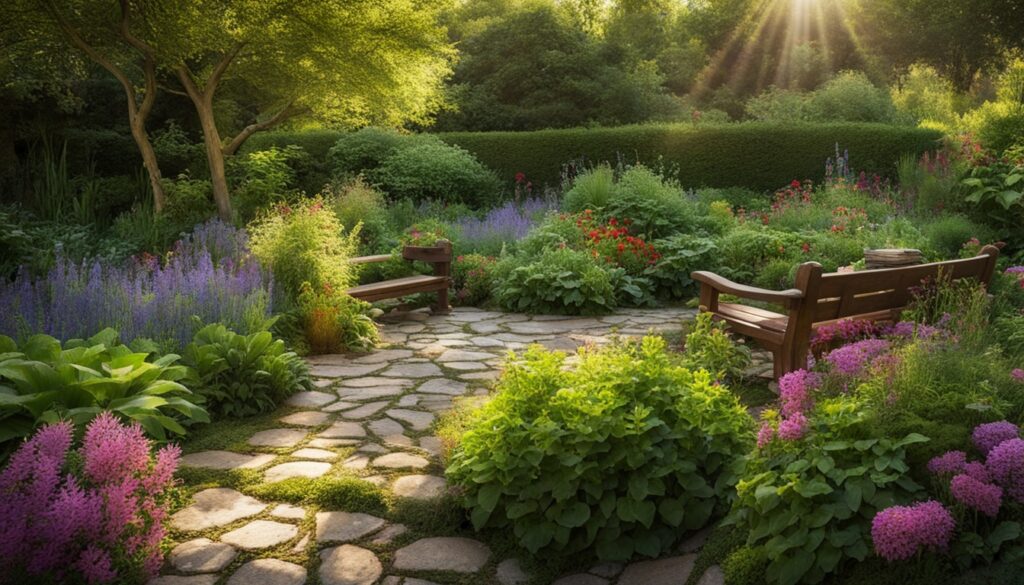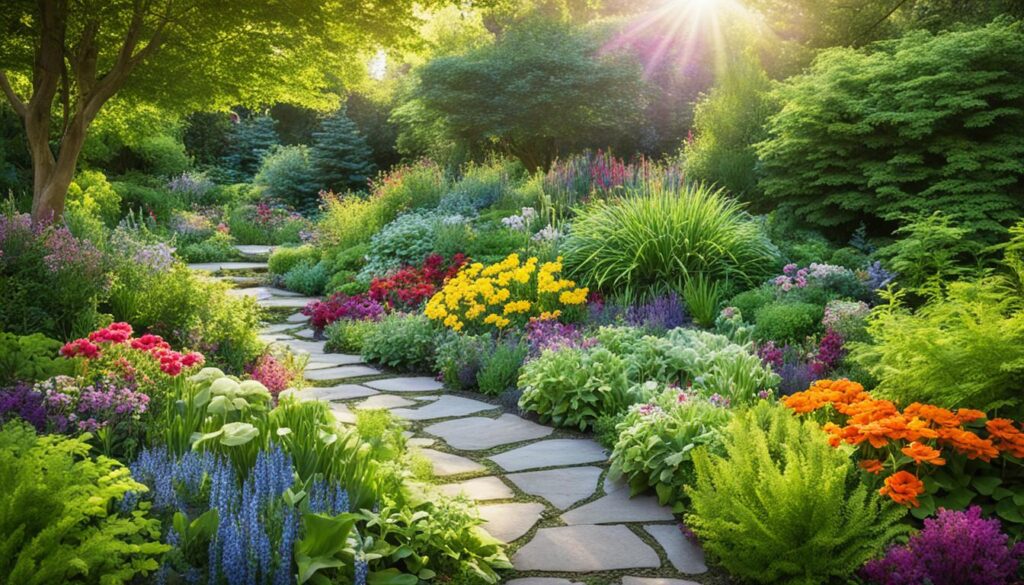This post contains affiliate links.
Have you ever walked through a meadow and felt its wild charm? That’s the heart of chaos gardening. It’s about embracing nature’s unplanned beauty. You let go of the need for neat rows and perfect plants. Instead, enjoy perennials from Jackson & Perkins blending with wild flowers. This not only looks beautiful but helps wildlife too—with little work from you.
Gardening lovers worldwide love chaos gardening for its unique benefits. It makes gardens lush, green, and full of life. It’s great for any gardener, whether you’re just starting or want to refresh your space. Chaos gardening is adventurous and rewarding.
Key Takeaways
- Chaos gardening offers a modern twist that aligns with nature’s spontaneity.
- It embraces randomness, providing a space for creativity and experimentation.
- Ch, aose gardens support biodiversity by mixing various seed types.
- Minimal maintenance is required, making it a cost-effective gardening method.
- Chaos gardens can serve as both aesthetic and ecological havens.
Introduction to Chaos Gardening
Chaos gardening offers a fresh take on ecological gardening. It avoids strict layouts, celebrating the random beauty of nature. It turns the garden into a spontaneous artwork of mixed seeds. This method allows seeds to grow naturally, creating a special creativity and eco-friendly vibe.
Self-seeding plants are the stars in chaos gardening. They make gardens easy to take care of and beautiful to look at. You can choose different self-sowers for varied effects like tall plants, wild styles, or shady spots. When doing sustainable landscaping, choose plant types that are manageable and won’t spread too much. It’s all about mixing wild beauty with a bit of order.
But, you need to be careful with invasive plants. Brambles, dandelions, and others can quickly take over. Instead, use plants like clover as a better, low-maintenance alternative to dandelions. Embracing rewilding with the right plants makes your garden eco-friendly and gorgeous.
| Plant Type | Recommendations |
|---|---|
| Tall Self-Sowers | Sunflowers, Hollyhocks |
| Wild Look Plants | Foxgotes, Poppies |
| Shade Loving | Forget-Me-Nots, Ferns |
| Non-Invasive Ground Covers | Clover |
Understanding the Philosophy Behind Chaos Gardening
Chaos gardening celebrates the unexpected. It goes against traditional garden norms, highlighting spontaneous growth. Permaculture and rewilding are key to understanding this approach.
The Role of Permaculture in Chaos Gardening
Permaculture is central to chaos gardening. It aims for gardens to be self-sustaining, similar to natural ecosystems. This mix supports a variety of plants, embracing minimal human interference.
Why Rewilding Thrives in Chaos Gardens
Rewilding is fundamental in chaos gardens. It allows natural processes to recover and creates homes for wildlife. With more biodiversity, these gardens mimic wild, untouched areas. They welcome insects that are good for the ecosystem.
Chaos gardens blend unpredictability with nature’s rhythm. They work in both small and large spaces. This combination encourages a diverse and lively environment.
| Aspect | Benefit |
|---|---|
| Permaculture Practices | Sustainable land use and self-sufficiency |
| Rewilding | Restoration of natural processes and creation of wildlife habitats |
| Biodiversity | Promotes a balanced and thriving ecosystem |
| Organic Gardening | Alignment with natural processes and minimal human intervention |
Thus, chaos gardening embodies permaculture and rewilding principles. It creates environments rich in biodiversity where nature thrives unchecked. It transforms gardens into wonders of nature’s spontaneity.
Steps to Create Your Own Chaos Garden
Creating a chaos garden is easy. Let nature do its work. This gardening style is about unpredictability and being eco-friendly.
Choosing the Right Spot
Find a sunny place for your garden. It should get at least six hours of sun daily. Plants love their sunlight!
Picking the Perfect Plant Varieties
Mix different types of plants. Use perennials, roses, wildflowers, and native plants. This mix creates a colorful, tough garden, like nature’s own.
Planting Techniques for a Chaos Garden
Don’t plant in straight lines. Use scatter planting. Throw mixed seeds with soil or compost on your site. Water them right after for best growth.

Implementing Minimal Maintenance Practices
A chaos garden is easy to take care of. Once plants grow, they mostly care for themselves. Just water and fertilize sometimes. This organic method is all about letting plants reseed by themselves.
This method brings bees and butterflies. You’ll deal with some pests, but it’s manageable. Chaos gardening is fun and great for the environment.
- Choose a sunny spot
- Select diverse plant varieties
- Employ scatter planting techniques
- Adopt minimal maintenance practices
The Importance of Native Plants in Chaos Gardening
Chaos gardening is magical with native plants. They bring natural beauty and are easy to take care of. These plants link the garden to local ecology, creating a beautiful scene.
Supporting Local Wildlife with Native Plants
Ecological gardening shines because of native plants. They help bees, butterflies, and birds by providing food and shelter. Gardeners who pick local plants create a safe place for wildlife. This makes the garden a bustling hub of life.
Low-Maintenance Benefits of Native Flora
Using native plants means less work. They’re strong and cope well with local conditions. You won’t need to worry about watering or pests much.
This makes your garden grow with little effort. It’s good for nature and easy on the gardener. Chaos gardening becomes a creative and eco-friendly project.
Here’s a quick glance at some chaos gardening essentials:
| Aspect | Native Plants |
|---|---|
| Support Local Wildlife | High |
| Maintenance Level | Low |
| Ecological Impact | Positive |
| Adaptability | High |
Eco-Friendly Gardening with Chaos Methods
In the world of chaos gardening, we focus on sustainability and eco-friendliness. This approach lets nature lead, creating a thriving, self-sufficient place. Chaos gardening aligns with nature, cutting down our need to step in or use chemicals.

Sustainable Practices in Chaos Gardening
Chaos gardening takes cues from natural habitats for sustainable landscaping. It involves spreading a variety of seeds, allowing plants to grow as they will. This method draws in helpful insects, supports wildlife, and needs little upkeep. By using nature’s randomness, chaos gardening saves resources and lessens environmental harm.
Reducing Chemical Use in Your Garden
Chaos gardening greatly cuts down on chemicals. Wild gardens help plants become tough and resilient without synthetic help. This makes the garden safer for both plants and wildlife. Adding sustainable methods to your chaos garden boosts biodiversity and balances the ecosystem.
Maximizing Biodiversity in a Chaos Garden
Chaos gardens are lively spaces full of different plants and animals. They show the beauty of wild, sustainable gardening. By planting in a random but planned way, these gardens become full of life and help the local environment a lot.
Attracting Pollinators and Beneficial Insects
Adding different flowering plants attracts bees and butterflies. California poppies, for example, are easy to care for and seed themselves. They bring bright colors and help bring in important pollinators for a healthy garden.
Using native plants is also a great strategy. They’re already suited to the area, so they need less care. They draw in local pollinators and helpful insects, making the garden’s ecosystem richer.
Creating a Balanced Ecosystem
To balance a chaos garden’s ecosystem, do more than just plant flowers. Adding stick or rock piles, rotting logs, and compost piles creates homes for different animals. These spots are perfect for insects and small animals to find shelter, mate, and eat, which boosts the garden’s biodiversity.
Mixing trees, shrubs, and ground covers creates varied habitats. Using native plants attracts local wildlife quickly, making a thriving and balanced ecosystem.
| Key Element | Benefit | Examples |
|---|---|---|
| Flowering Plants | Attract Pollinators | California Poppies, Wildflowers |
| Stick/Rock Piles | Create Habitats | Small Mammals, Insects |
| Rotting Logs | Enhane Soil Biodiversity | Decomposers, Fungi |
| Native Plants | Support Local Wildlife | Local Wildflowers, Grasses |
Blending chaos gardening basics with strategic elements can make vibrant, sustainable landscapes. These gardens support a wide variety of life.
The Therapeutic Benefits of Chaos Gardening
Chaos gardening is more than just a way to help the environment. It also improves our mental health. Working with wild nature reduces stress and makes us happy. By planting a chaos garden, we enjoy the beauty and balance of nature that happens on its own.

Stress Reduction Through Gardening
Our busy lives need breaks, and chaos gardening offers that. It lets us connect with nature without the need for constant control. This peaceful approach lets plants grow on their own, reducing our stress.
The Joy of Spontaneity in Nature
The excitement comes from not knowing what will happen next. Each day brings a new surprise in a chaos garden. Seeing different plants and animals thrive without meticulous plans is joyful. The deep connection to life’s cycles in chaos gardening is truly healing.
Learn about how chaos gardening celebrates nature’s spontaneity and its many uplifting effects.
| Statistic | Impact |
|---|---|
| Promotion of Biodiversity | Incorporates various plant species to support ecosystem resilience and beneficial organisms |
| Reduction of Artificial Inputs | Lowers dependence on chemicals through natural companion planting and composting |
| Usage of Native Plants | Supports local ecosystems by providing food and shelter for wildlife |
| Climate Considerations | Selects resilient species to adapt to changing weather patterns |
Chaos Gardening
Chaos gardening is a unique and freeing way to garden. It celebrates the unexpected instead of perfect garden rows. Gardeners let plants naturally decide where and how to grow. This approach requires less work and lets nature play a lead role.
Chaos gardening is gaining fame, especially online. On TikTok, videos on the topic have been viewed over 13 billion times. Meg Grows Plants (@meggrowsplants) is one who shares her journey. Her video on growing carrots wildly has almost 900k views and over 110k likes.
Plant selection is key in chaos gardening. Choosing long-living and native plants makes the garden easy to care for. It’s also about having plants help each other grow. For a beautiful chaos garden, think about adding Angelica archangelica and Cirsium rivulare ‘Atropurpureum’.
Plants like Verbena bonariensis and Eschscholzia californica add to the garden’s spontaneity. For darker spots, foxgloves and Meconopsis cambrica are perfect. They grow on their own, making the garden naturally vibrant.
In chaos gardening, there isn’t much work to do. Just water new seeds and thin the young plants. Yet, be mindful of local rules about how your garden should look, especially in the front yard.
Avoid letting aggressive weeds like brambles take over. Better options include letting clover flourish or using nettles in containers to attract butterflies. This keeps the garden easy to manage.
Chaos gardening brings a beautiful mess that welcomes wildlife. Mixing old seeds leads to unexpected plant growth and surprises. Even though success isn’t guaranteed, the joy of discovering new growth each season is immense. It’s a simple and rewarding way to garden organically.
| Aspect | Chaos Gardening | Traditional Gardening |
|---|---|---|
| Planning | Random and spontaneous | Meticulous and structured |
| Planting Techniques | Haphazard and mixed seeds | Specific methods and spacing |
| Maintenance | Low-maintenance | Regular maintenance |
| Environmental Impact | Promotes biodiversity | Less focus on biodiversity |
| Surprises | Frequent and delightful | Predictable and controlled |
Case Studies: Successful Chaos Gardens
Exploring chaos gardening opens up a world of enlightenment and intrigue. Through case studies, we see the transformation of ordinary gardening into ecosystems full of life and variety.
Transforming Traditional Gardens
In 2020, KoruKai Herb Farm in New Zealand kicked off a chaos gardening test. They set up two terraces on Banks Peninsula. One for growing medicinal herbs due to high demand and the other for a chaos garden. This garden used many cover crops to help the soil and its ecosystem. They planted a mix of 35 seeds, soaked in compost slurry to attract good microbes.
The chaos garden transformation was striking. In just eight weeks, it exploded with growth. Lush lettuces, beans, corn, sunflowers, kale, and other plants thrived. Over seven months, easy-to-grow veggies like salad greens and radishes did well. Corn and dry beans popped up too. However, zucchini and pumpkins struggled due to lack of light, being outpaced by faster-growing plants.
Tips from Experienced Chaos Gardeners
Experts in chaos gardening highlight its unpredictable but rewarding nature. They offer these vital tips:
- Soil Preparation: Improve soil by soaking seeds in compost slurry before sowing.
- Protection: Prevent wildlife from eating seeds and young plants with bird netting.
- Diverse Planting: Sowing different seeds creates a diverse ecosystem that adapts to changing weather.
- Maintenance: Keep up minimal upkeep with some watering and fertilizing as the garden self-regulates.
Below is a summary of key observations from the KoruKai Chaos Garden:
| Aspect | Details |
|---|---|
| Seed Mix | 25 seeds from KoruKai, 10 from King Seeds |
| Preparation | Soaked in compost slurry for 24 hours |
| Protection | Bird netting over seeds and seedlings |
| Growth Period | 8 weeks to significant growth, 7 months to maturity |
| Main Crops | Lettuce, beans, corn, sunflowers, kale, silverbeet, spinach |
| Unexpected Crops | Corn, dry beans |
These findings celebrate the wins of chaos gardening. This approach brings the wildness and richness of nature into our yards. It refreshes old gardening ways while promoting sustainable and eco-friendly practices.
Common Challenges and Solutions in Chaos Gardening
Chaos gardening is full of surprises but also has its share of challenges. These include balancing the competition between plants and handling invasive species. Thankfully, there are sustainable ways to tackle these issues.
The competition between different plant species is a big deal in chaos gardens. These gardens mix lots of plant types, which is pretty but can cause issues. Certain plants might grow too big, blocking sunlight from others. To avoid this, gardeners can remove some plants and think about the natural balance before planting.
Invasive species are another big worry for chaos gardeners. These are plants that can take over if not checked. Gardeners need to watch out for these plants and act quickly when they spot them. Regular checks help keep the garden diverse without losing its wild charm.
Organic practices are central to controlling pests and diseases in chaos gardens. By welcoming helpful bugs and using natural fertilizers, gardens stay healthy. This approach helps avoid harmful chemicals, keeping the garden green in every sense.
| Challenge | Solution |
|---|---|
| Species Competition | Selective thinning, mindful planting |
| Invasive Species | Ongoing monitoring, prompt action |
| Pests and Diseases | Organic practices, beneficial insects |
Adapting to climate changes is also essential. Picking plants that can handle these changes is vital. This way, chaos gardens can thrive even as the weather shifts.
In the end, knowing how ecosystems work and using sustainable solutions are key to handling the challenges in gardening. By following these methods, gardeners can create beautiful, eco-friendly, and tough gardens.
Conclusion
Chaos gardening is a fresh approach that encourages going back to nature. It stands out by creating stunning, easy-care gardens full of life. Many garden lovers are now choosing this method for its simplicity and the vibrant ecosystem it creates.
The focus on native plants in chaos gardening is quite strong. This is because these plants are well-suited to local conditions and help wildlife. Gardeners will find a variety of colorful plants priced between $29.99 and $54.99. Choices include several types of cone flowers and different hydrangea species.
Compared to regular gardens, chaos gardens need much less upkeep and hardly any pruning. This approach boosts biodiversity, leading to a balanced and self-supporting garden environment. With more people trying chaos gardening, the chances to create sustainable and lovely gardens are growing. For additional information, check out the trend of chaos gardening.
FAQ
What is chaos gardening?
How does chaos gardening differ from traditional gardening?
What role does permaculture play in chaos gardening?
Why is rewilding important in chaos gardens?
How do I choose the right spot for a chaos garden?
What plants should I select for a chaos exotic garden?
What are the planting techniques for chaos gardening?
How can I maintain a chaos garden with minimal effort?
How do native plants benefit a chaos garden?
What are sustainable practices in chaos gardening?
How can chaos gardening reduce chemical use?
How does chaos gardening maximize biodiversity?
What therapeutic benefits does chaos gardening offer?
Can traditional gardens be transformed into chaos gardens?
What tips do experienced chaos gardeners offer?
What are common challenges in chaos gardening?
This post contains affiliate links.

